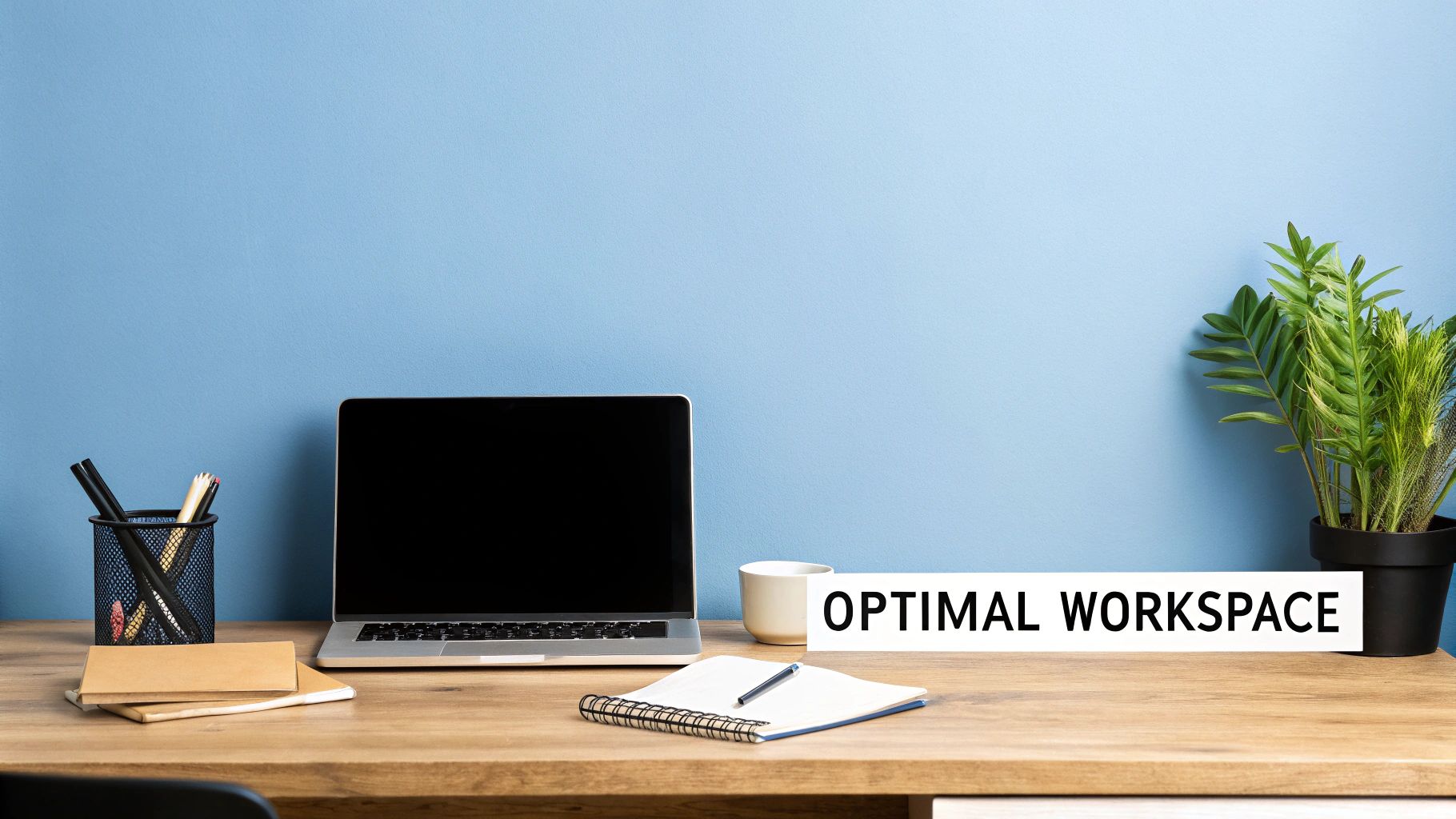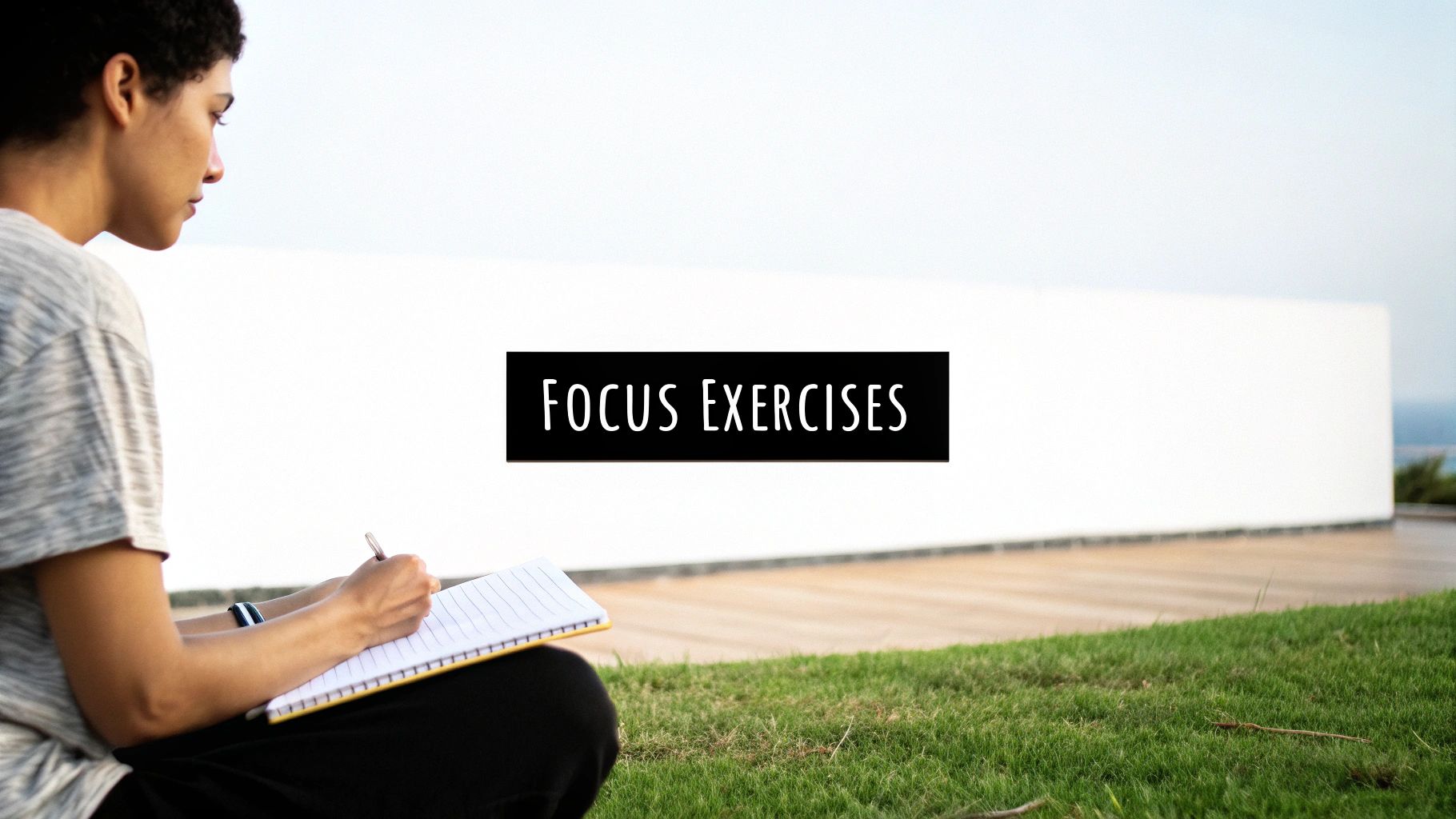
How to Focus Better: Proven Tips for Productivity
The Modern Focus Crisis: What's Really Happening
Maintaining focus in today's world, especially in the UK, can feel incredibly challenging. The constant barrage of notifications, the expectation of multitasking, and the sheer volume of information we encounter daily make it harder than ever to concentrate and engage in deep, meaningful work. But what's the underlying neuroscience behind this struggle with distraction?
The Neuroscience of Distraction
Our brains aren't designed for constant task-switching. Each notification, ping, or email triggers a release of dopamine, the neurotransmitter associated with pleasure and reward. This creates a feedback loop: we crave these digital interruptions, even as they fracture our attention. Technology companies, often unintentionally, exploit this neurological tendency by designing apps and platforms to maximize engagement, which often translates to increased distraction. Understanding this dynamic is the first step towards regaining control of our attention.
Myths vs. Reality: Are Our Attention Spans Shrinking?
The common perception is that our attention spans are shrinking, but the reality is more complex. A survey conducted by King's College London revealed that 49% of the UK public believe their attention span has decreased, and 67% recognize the negative consequences of switching between digital media. However, this doesn't necessarily indicate a diminished capacity for focus. Rather, we've become conditioned to respond to constant stimuli, making sustained concentration more challenging.
Generational Differences and Focus
Experiences with focus vary across generations. Younger generations, having grown up immersed in technology, may face different challenges than older generations adapting to a constantly connected world. This creates unique hurdles in both the workplace and at home, emphasizing the need for focus strategies tailored to individual needs and circumstances. For further insights, explore resources like Dad Fix Club.
Why Focus Matters Now More Than Ever
Improving focus isn't solely about productivity; it's crucial for overall well-being. Difficulty concentrating can contribute to heightened stress, reduced job satisfaction, and even strained relationships. By learning how to focus effectively, we can reclaim our time, energy, and mental clarity. This leads to greater fulfillment and success in all aspects of life and paves the way for exploring practical strategies to navigate the modern focus crisis and enhance concentration.
The Self-Care Foundation: Fueling Your Focus Engine

Your focus isn't a standalone mental skill. It's fundamentally connected to your overall well-being. Think of your focus as a car engine. Even the most powerful engine needs the right fuel and regular maintenance. Your brain also needs the right "fuel" and care to perform at its best.
This means prioritizing sleep, nutrition, hydration, and movement. These fundamental elements are vital for improving focus, yet they're often neglected in favor of quick fixes. Top performers know that self-care isn't a luxury; it's a requirement for sustained focus and high performance.
The Impact of Sleep on Focus
Sleep is arguably the most important element of self-care for optimal brain function. While you sleep, your brain consolidates memories, removes toxins, and recharges for the coming day. Lack of sleep leads to diminished cognitive function. This includes a shorter attention span, impaired decision-making, and difficulty concentrating, all of which impact your ability to focus effectively.
Nutrition and Hydration: Fueling Your Brainpower
What you consume directly affects your brain's performance. A diet rich in whole foods, healthy fats, and complex carbohydrates provides consistent energy and supports cognitive function. On the other hand, processed foods, sugary drinks, and too much caffeine can cause energy crashes and hinder focus. Proper hydration is equally important. Even mild dehydration can negatively impact concentration and cognitive performance.
Movement and Mental Clarity
Regular physical activity is crucial for both physical and mental health, including focus. Exercise increases blood flow to the brain and stimulates the production of brain-derived neurotrophic factor (BDNF). BDNF is a protein essential for learning and memory. Physical activity also enhances overall cognitive function. Even short bursts of activity throughout the day can significantly improve your concentration.
A growing emphasis on self-care is also apparent. For example, a Hearst UK survey found that 84% of respondents believe there should be more emphasis on self-care. You can find more detailed statistics here. This underscores the growing awareness of the connection between well-being and performance. Incorporating these self-care practices creates a strong foundation for effective focus strategies, leading to better cognitive function and sustained concentration.
Engineering Your Environment for Deep Focus
Your physical environment plays a significant role in your ability to focus. This section explores how to optimize your workspace for maximum concentration, based on the psychology and neuroscience of workspace design. Just as a well-organized kitchen simplifies cooking, a thoughtfully designed workspace promotes deep focus.
Desk Placement and Ergonomics: Setting the Stage for Focus
The position of your desk and the setup of your workstation can drastically impact your focus levels. For instance, placing your desk near natural light can boost both mood and alertness. Ergonomics are also critical. An uncomfortable chair or a poorly positioned monitor can cause physical discomfort, pulling your attention away from your work. Consider investing in an ergonomic chair and ensuring your monitor is at eye level.
To get a deeper understanding of the potential benefits of an ergonomic workspace, you might consider visiting the website of the American Occupational Therapy Association (AOTA).
Lighting and Sound: Subtle but Powerful Influences
Lighting and sound are often underestimated factors that deeply affect concentration. Bright, natural light is best for focus, while dim lighting can induce drowsiness. Similarly, excessive noise can be very distracting. Think about using noise-cancelling headphones or playing ambient sounds to cultivate a more productive atmosphere. Even small adjustments to lighting and sound can notably improve concentration. If you're interested in learning more about managing noise levels, resources like the National Institute for Occupational Safety and Health (NIOSH) can be valuable.
Eliminating Distractions: Creating an Attention Sanctuary
Both physical and digital distractions can significantly hinder focus. A cluttered workspace, for example, can make it difficult to concentrate. This means keeping a tidy desk, minimizing interruptions, and setting clear boundaries. Addressing both physical and digital clutter is vital for a focus-friendly environment. Tools like Evernote or Trello can be instrumental in managing digital organization and tasks.
Tailoring Your Environment: Different Tasks, Different Spaces
Different kinds of work benefit from different environments. You might prefer a quiet, minimalist setting for deep work, while a more collaborative atmosphere might be better suited for brainstorming or meetings. Successful knowledge workers frequently establish distinct environments for various tasks. It's like having specialized tools for different jobs.
Focus-Enhancing Principles in Shared Environments
Implementing these principles in open offices or shared workspaces can be a challenge. However, even minor adjustments can have a significant positive effect. Using noise-cancelling headphones, creating a visual barrier with a plant, or strategically positioning your desk can provide a sense of privacy and minimize distractions. This helps carve out a focused zone, even in a busy setting.
To further enhance your understanding of workspace optimization, especially in shared environments, you can explore resources from the International Facility Management Association (IFMA).
Let's delve into some specific environmental factors and their potential impact on focus, along with strategies for optimization:
To help you better visualize the impact and potential improvements, we've compiled the following table:
Environmental Focus Factors Comparison This table compares different environmental elements and their impact on focus levels.
| Environmental Factor | Potential Distraction Level | Optimization Strategies | Expected Focus Improvement |
|---|---|---|---|
| Noise | High | Noise-cancelling headphones, white noise machine, soundproofing | Significant |
| Lighting | Medium | Natural light, adjustable task lighting, minimizing glare | Moderate to High |
| Clutter | Medium | Regular decluttering, designated storage, minimalist workspace | Moderate |
| Temperature | Low to Medium | Maintaining a comfortable temperature, layering clothing | Low to Moderate |
| Ergonomics | Medium to High | Ergonomic chair, adjustable desk, proper monitor placement | Moderate to High |
| Interruptions | High | Setting boundaries, scheduled focus time, communication protocols | Significant |
By understanding these environmental influences and implementing appropriate strategies, you can create a workspace that promotes deep focus and boosts productivity. Remember that even small changes can yield substantial improvements in your ability to concentrate and achieve your goals.
Digital Detox That Works (Without Going Offline)

Completely disconnecting from the digital world is a challenge for most of us, especially given our interconnected lives. This section explores how to improve focus not by abandoning technology, but by changing how we interact with it. We'll explore creating a digital environment that enhances, rather than hinders, our concentration. For more tips, check out this resource: How to master....
Managing Notification Overload: Taking Back Control
One of the biggest obstacles to focus is the constant barrage of notifications. These digital interruptions break our concentration and condition our minds to seek distraction. Regaining control is key.
This means disabling non-essential notifications and scheduling specific times for checking emails and social media. By consciously choosing when to engage with these platforms, we lessen their disruptive impact on our focus.
Strategic Technology Breaks: Refreshing Your Mental State
Our minds, like our bodies, need breaks. Stepping away from our screens allows our brains to recharge and process information efficiently. Implementing strategic technology breaks throughout the day can greatly improve focus.
This could include short walks, mindful breathing exercises, or simply looking out the window. Even a few minutes can refresh our mental state and boost concentration.
Setting Boundaries with Social Media and Email: Protecting Your Attention
Social media and email are designed to be engaging, often vying for our attention and pulling us away from important tasks. Establishing meaningful boundaries is crucial.
This might involve designating specific times for checking these platforms or using website blockers like Freedom to limit access during focus periods. Clear boundaries protect our attention and help maintain focus.
Focus-Enhancing Apps and Tools: Leveraging Technology for Good
While technology can be distracting, it can also be a powerful tool for enhancing focus. Numerous apps and tools can help minimize distractions, improve time management, and cultivate better focus habits.
These resources can provide valuable support. Consider using apps that block distracting websites, track focused time using techniques like the Pomodoro Technique, or offer guided meditation exercises.
Digital Minimalism: Simplifying Your Digital Life
Digital minimalism is a philosophy of intentionally choosing which technologies we use. It emphasizes focusing on tools that add genuine value and minimizing the rest.
This approach helps declutter our digital lives and regain control of our attention. Consider unsubscribing from unnecessary email lists, deleting unused apps, and being more mindful of our online activities.
Intentional Technology Use: Shifting from Reactive to Proactive
Instead of reacting to every notification and email, we can choose to interact with technology more intentionally. This means scheduling specific times for checking messages, engaging with social media, and completing online tasks.
By being proactive instead of reactive, we regain control of our digital lives and protect our focus. This shift allows us to use technology as a tool to achieve our goals, rather than allowing it to control our attention.
Focus-Enhancing Productivity Systems That Deliver

Moving beyond basic time management, we explore productivity systems designed to sharpen cognitive focus. This involves examining techniques like the Pomodoro Technique, time-blocking, and deep work protocols. We’ll explore how these systems interact with various thinking styles and work environments.
The goal is to identify methods aligning with your cognitive preferences and work demands. This moves us away from generic solutions toward personalized strategies.
The Pomodoro Technique: Focused Bursts For Maximum Output
The Pomodoro Technique uses focused work intervals, typically 25 minutes, followed by short breaks. This structure leverages the brain's natural rhythms and sustains concentration through regular rest periods.
These focused bursts can power you through tasks and reduce mental fatigue. The built-in breaks help prevent burnout and maintain a sustainable work pace. This makes the Pomodoro Technique especially helpful for those struggling with prolonged focus.
Time-Blocking: Structuring Your Day For Optimal Focus
Time-blocking involves scheduling specific time blocks for particular tasks or activities. This structure reduces the mental burden of deciding what to work on next.
Allocating dedicated time slots allows you to prioritize crucial tasks and minimize distractions. Time-blocking promotes a sense of control over your schedule and facilitates deep, focused work. It encourages proactive planning rather than reactive task management.
Deep Work Protocols: Creating Space For Undistracted Concentration
Deep work requires extended periods of uninterrupted concentration. This means minimizing internal and external distractions to facilitate focused, high-quality work.
Deep work protocols create environments conducive to sustained concentration. This might include designating specific times for deep work, finding a quiet workspace, and communicating your availability to others.
Establishing these boundaries is key for maximizing focus and achieving a flow state. This is particularly valuable for complex projects demanding significant cognitive effort. Even seemingly external factors, like UK public sector productivity, can influence individual focus.
Matching Techniques To Cognitive Tasks: Optimizing Your Approach
Different focus techniques suit different tasks. What works for one task might be ineffective for another. Learning to match productivity techniques to various cognitive tasks is crucial.
For example, the Pomodoro Technique may be ideal for writing or coding, while time-blocking suits planning or project management. Top performers adapt their approaches based on the work, maximizing focus and efficiency.
Progressive Training And Measurement: Building Focus Capabilities
Like any skill, focus improves with practice. Progressive training, starting with shorter focus periods and gradually increasing duration, builds focus capabilities.
Tracking your progress is also important. Measuring improvements maintains motivation and provides feedback for refining your approach. Metrics like focused time and task completion rates help identify effective strategies and optimize focus for lasting results.
To further illustrate how different techniques can be applied, consider the following comparison:
Focus Technique Comparison
This table compares different focus and productivity techniques based on their key features and benefits.
| Technique | Best For | Time Commitment | Implementation Difficulty | Focus Benefit |
|---|---|---|---|---|
| Pomodoro Technique | Tasks requiring short bursts of focus | 25 minutes + breaks | Easy | Reduces mental fatigue, improves concentration |
| Time-Blocking | Planning, project management, deep work | Variable, scheduled | Medium | Structures time, minimizes distractions |
| Deep Work Protocols | Complex tasks, deep thinking | Extended periods | Medium | Enables extended focus, facilitates flow states |
As shown in the table, each technique offers unique advantages depending on your needs and the task at hand. Experimenting with different methods will help you discover the best approach for maximizing your productivity and focus.
Training Your Brain: Cognitive Exercises That Work

Can you strengthen your focus like a muscle? Neuroscience suggests the answer is yes. This improvement, however, requires the right training methods. This section explores evidence-based cognitive exercises proven to enhance attention capacity over time. Interested in learning more? Check out this resource: How to master.... We'll move beyond simple concentration tips and delve into practices that create lasting neurological adaptations.
Mindfulness Meditation: Training Your Attention Muscle
Mindfulness meditation is more than just relaxation; it's a powerful tool for training your attention. By focusing on your breath, bodily sensations, or external stimuli, you learn to observe your thoughts without judgment. This practice strengthens your ability to resist distractions and maintain present moment focus. Regular mindfulness can lead to structural changes in the brain, particularly in areas associated with attention and focus.
For example, studies show increased grey matter density in the prefrontal cortex, a region crucial for executive functions like attention and decision-making.
Progressive Attention Exercises: Gradually Increasing Your Capacity
Like any muscle, your attention span can be strengthened through progressive training. This involves gradually increasing the duration of your focus periods. Start with shorter intervals, perhaps 5-10 minutes, and gradually increase the time as your focus improves. This avoids overwhelming your brain and builds a sustainable foundation for sustained concentration.
For example, begin by focusing on a single task for 10 minutes without interruption. As you improve, incrementally increase the duration to 15, 20, and eventually 30 minutes or more. This progressive approach is especially helpful for those struggling with short attention spans.
Cognitive Challenges: Sharpening Your Mental Acuity
Specific cognitive challenges, such as puzzles, memory games, and problem-solving tasks, can sharpen your mental acuity and improve overall focus. These activities stimulate different parts of your brain, including those responsible for attention, working memory, and executive functions.
Regularly engaging in these challenges helps maintain cognitive fitness and enhances your ability to concentrate effectively. Consider it cross-training for your brain, working different cognitive "muscles." This multifaceted approach keeps your brain sharp and adaptable.
Brain Training Apps: Separating Hype From Reality
While many brain training apps promise improved focus, the reality is more nuanced. Some apps rely on repetitive tasks that may not translate to real-world benefits. However, other platforms offer engaging cognitive challenges shown to benefit attention and working memory.
Choose apps backed by research and designed to target specific cognitive functions related to focus. This discernment will help you find effective programs. Remember that no app can replace consistent, real-world practice. Combining app-based training with practical exercises and mindfulness creates a more holistic and effective approach.
Building Focus Habits That Actually Stick
Cultivating lasting focus isn't about willpower. It's about establishing effective habits. This section connects understanding focus techniques with integrating them into your daily routine. By using principles from behavioral science and habit formation research, you can transform focus strategies into automatic routines. This creates sustainable practices, improving your focus long after you finish this guide.
Designing Habits That Work for You
Effective focus habits should complement your natural rhythms and preferences. For instance, if you're most alert in the morning, schedule your most demanding cognitive tasks then. If noise easily distracts you, create a quiet workspace for focused work. Understanding your individual needs is vital for designing habits that last. This personalized approach maximizes your chances of success.
Creating Systems for Effortless Focus
Make focus the easiest choice. Set up systems that support your objectives. This could include preparing your workspace the evening before, silencing notifications during work, or scheduling regular breaks. By eliminating obstacles and creating a supportive structure, you simplify maintaining focus and avoiding distractions.
Realistic Progression: Building Focus Over Time
Don't expect to become a focus expert overnight. Begin with small, achievable objectives and gradually increase the difficulty as your focus develops. This gradual progression prevents you from feeling overwhelmed and builds confidence. For example, start by focusing on a single task for 15 minutes without interruption. Once comfortable, slowly extend the duration. This step-by-step method builds sustainable habits. You can also boost focus through cognitive exercises. Consider exploring Mindfulness Oevelser for further information.
Tracking Progress and Adapting Strategies
Monitor your progress to stay motivated and identify effective strategies. Track your focused time, the number of tasks completed, or other relevant metrics. This data provides valuable insights into your focus patterns, allowing you to adjust your strategies as needed. Regular review and adaptation are crucial for continuous improvement.
Overcoming Setbacks and Staying on Track
Setbacks are unavoidable. Don't be discouraged by occasional lapses in focus. View them as opportunities to learn and refine your approach. Identify contributing factors and develop strategies to avoid them in the future. This resilience ensures long-term success.
By understanding the psychology of habit formation, you can build sustainable practices that continuously enhance your focus capabilities. This empowers you to manage your attention effectively and achieve your goals. Remember, consistent effort and adaptation are key to mastering the art of focus.
Ready to reclaim your focus and unlock your full potential? DadFix's Reboot supplement is designed to support your journey by enhancing mental clarity, managing stress, and boosting cognitive function. Learn more about how DadFix can help you optimize your performance and well-being at https://www.dadfixclub.com.
Article created using Outrank
